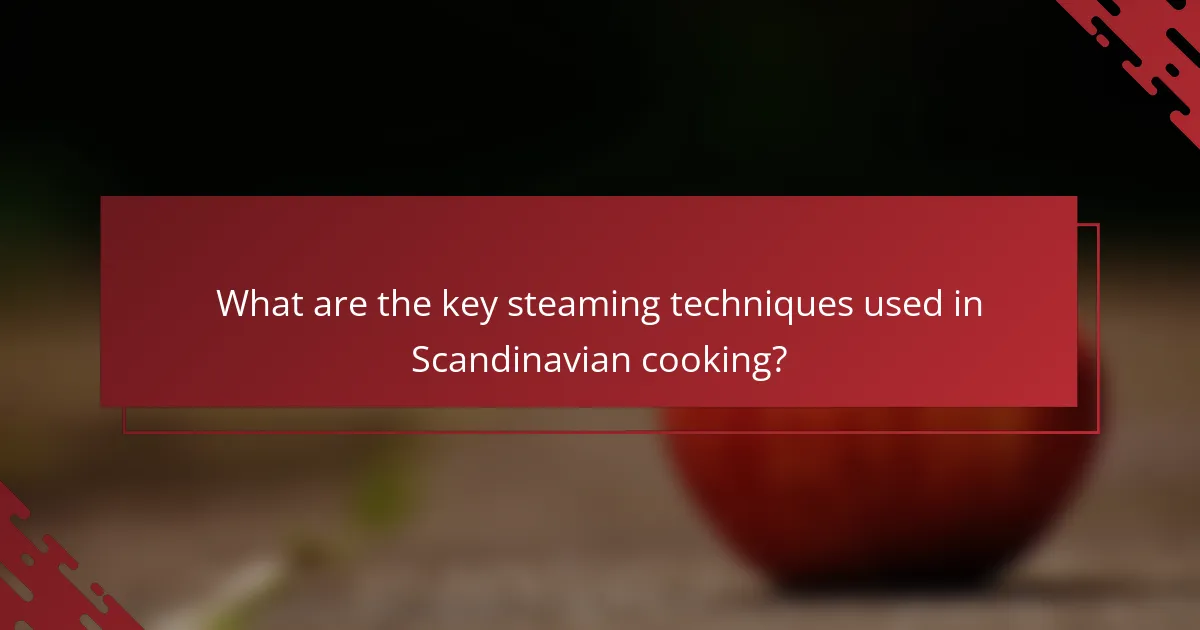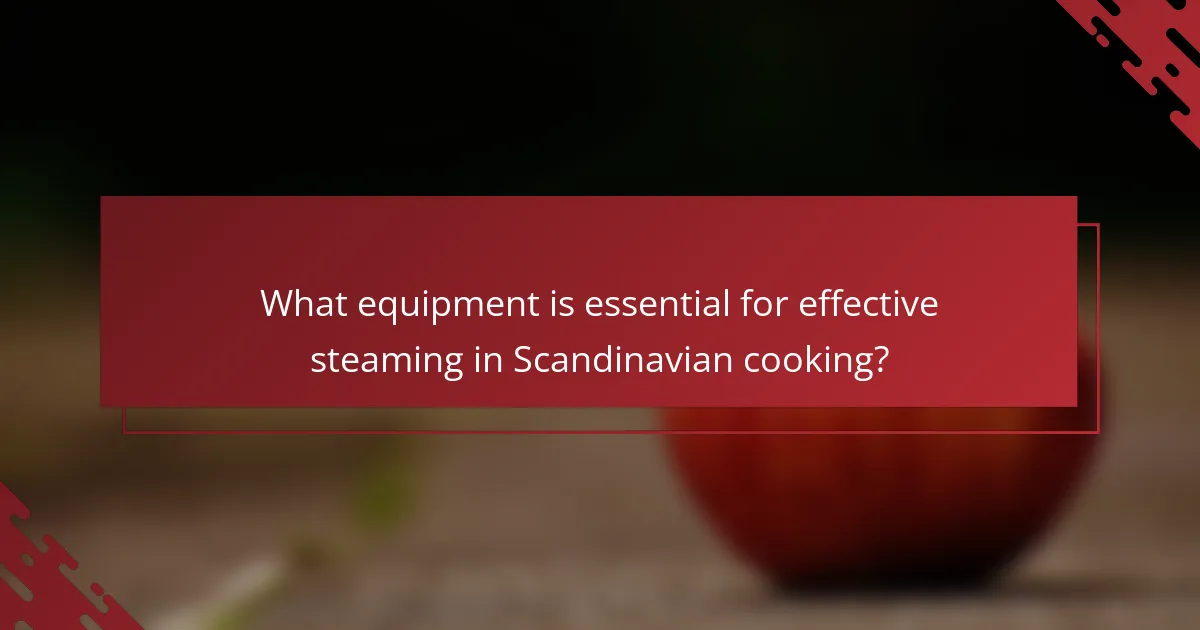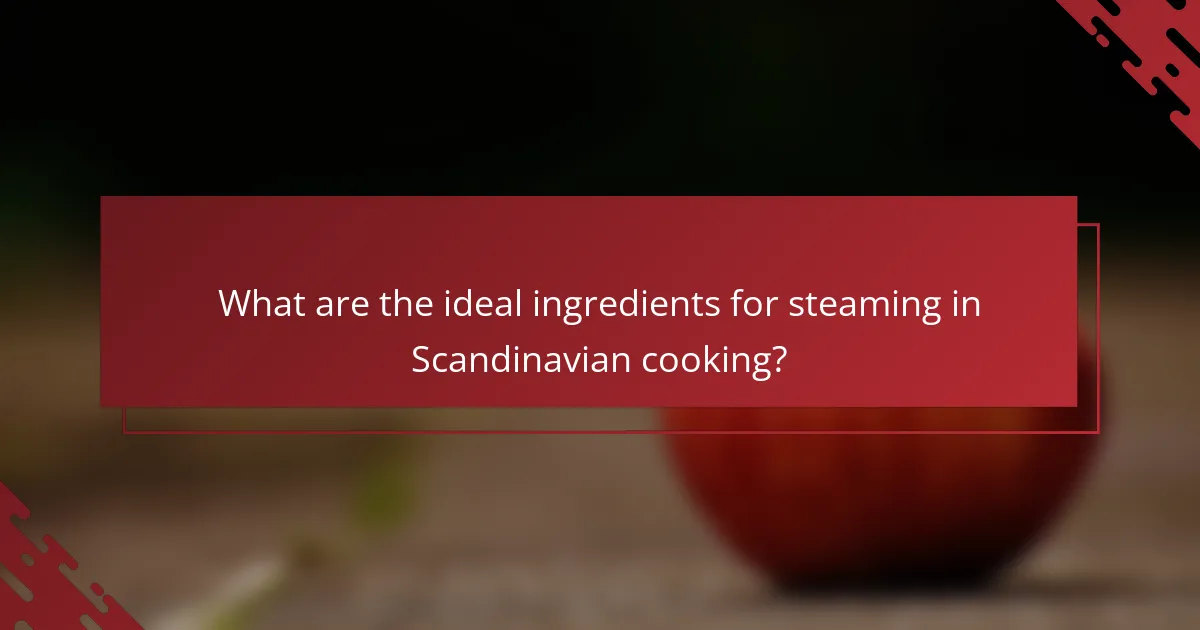Steaming techniques in Scandinavian cooking encompass methods such as steamer basket steaming, pot steaming, and parchment paper steaming. These techniques are essential for preserving the nutrients and enhancing the flavors of key ingredients, including fish like salmon and root vegetables. Effective steaming requires specific equipment, including a steamer basket, a tightly sealed pot, and a reliable heat source. The ideal ingredients for steaming in this cuisine include fish, root vegetables, and leafy greens, all of which benefit from this traditional cooking method by retaining moisture and nutritional value without the need for excessive seasoning.

What are the key steaming techniques used in Scandinavian cooking?
Key steaming techniques in Scandinavian cooking include using a steamer basket, pot steaming, and parchment paper steaming. Steamer baskets are often placed over boiling water to cook fish and vegetables gently. Pot steaming involves placing food directly in a pot with a small amount of water, covered tightly to retain steam. Parchment paper steaming, known as “en papillote,” seals food in paper to trap moisture and flavors. These methods preserve nutrients and enhance the natural flavors of ingredients. Steaming is a traditional cooking method in Scandinavian cuisine, particularly for fish like salmon and root vegetables.
How do steaming techniques differ from other cooking methods?
Steaming techniques differ from other cooking methods by using steam to cook food rather than direct heat. This method retains more nutrients compared to boiling or frying. Steaming prevents the loss of vitamins that can occur in water-based cooking. The food remains moist without added fats, promoting healthier meals. Unlike grilling or roasting, steaming does not create a crispy texture. It is often quicker than baking and can cook multiple items simultaneously. Studies show that steaming can reduce cooking time by up to 50%. This efficiency makes it a preferred method in Scandinavian cooking, where preserving flavor and nutrients is essential.
What are the advantages of using steaming in Scandinavian cuisine?
Steaming in Scandinavian cuisine offers several advantages. It preserves the natural flavors of ingredients. This technique allows for minimal seasoning, enhancing the dish’s authenticity. Steaming retains essential nutrients, making meals healthier. Studies show that steaming can preserve up to 90% of vitamins. It also reduces the need for added fats, promoting lighter dishes. Furthermore, steaming is a gentle cooking method, preventing overcooking. This results in tender textures, particularly in fish and vegetables. Overall, steaming aligns with Scandinavian culinary values of freshness and simplicity.
How do steaming techniques preserve nutrients in food?
Steaming techniques preserve nutrients in food by using moist heat that cooks food quickly. This method minimizes nutrient loss compared to boiling or frying. Water-soluble vitamins, like vitamin C and B vitamins, are particularly sensitive to heat and water. Steaming reduces the time food is exposed to high temperatures. It also prevents nutrients from leaching into cooking water. A study published in the Journal of Food Science found that steaming retains up to 90% of vitamins in vegetables. In contrast, boiling can result in a loss of 50% or more of these nutrients. Therefore, steaming is an effective cooking method for nutrient preservation.
What types of dishes are best suited for steaming in Scandinavian cooking?
Fish dishes are best suited for steaming in Scandinavian cooking. Popular examples include salmon, herring, and cod. These fish retain moisture and flavor when steamed. Vegetables such as carrots, potatoes, and leafy greens also work well. Steaming preserves their nutrients and enhances their natural taste. Traditional dishes like fiskekaker (fish cakes) benefit from steaming, ensuring a tender texture. Additionally, dumplings filled with meat or vegetables can be steamed effectively. This method aligns with the Scandinavian emphasis on health and freshness in cuisine.
Which traditional Scandinavian dishes utilize steaming techniques?
Traditional Scandinavian dishes that utilize steaming techniques include “klippfisk,” “fiskekaker,” and “grøt.” Klippfisk is dried and salted cod that is often rehydrated through steaming. Fiskekaker are fish cakes made from minced fish, typically steamed for a tender texture. Grøt refers to a porridge made from grains, which can also be prepared using steaming methods. These dishes highlight the importance of steaming in preserving flavors and nutrients while ensuring a moist texture.
How can steaming enhance the flavors of Scandinavian ingredients?
Steaming enhances the flavors of Scandinavian ingredients by preserving their natural taste and nutrients. This cooking method uses moist heat, which prevents the loss of essential oils and flavors. Ingredients like fish, vegetables, and grains retain their vibrant colors and textures when steamed. For instance, steaming salmon keeps it moist and flavorful without the need for added fats. Research shows that steaming can retain up to 90% of nutrients compared to boiling. This method also allows for the subtle flavors of herbs and spices to infuse into the ingredients effectively. Overall, steaming is an ideal technique for highlighting the fresh, clean flavors characteristic of Scandinavian cuisine.

What equipment is essential for effective steaming in Scandinavian cooking?
Essential equipment for effective steaming in Scandinavian cooking includes a steamer basket, a pot with a lid, and a heat source. A steamer basket, often made of stainless steel or bamboo, allows food to be placed above boiling water. This setup ensures even cooking while retaining nutrients and flavors. A pot with a tight-fitting lid is crucial to trap steam and maintain consistent temperature. A reliable heat source, such as a stovetop or induction cooker, is necessary to generate steam efficiently. These tools are foundational in traditional Scandinavian cooking methods, as they promote healthy meal preparation.
What types of steamers are available for home cooks?
Home cooks have several types of steamers available. These include stovetop steamers, electric steamers, and microwave steamers. Stovetop steamers often consist of a pot with a steaming basket. Electric steamers are standalone appliances that use electricity to generate steam. Microwave steamers are designed specifically for quick steaming in a microwave. Each type offers unique benefits for cooking various foods. For instance, stovetop steamers are versatile and suitable for larger batches. Electric steamers provide consistent results and ease of use. Microwave steamers are ideal for quick preparation of vegetables.
How do different steamers compare in terms of efficiency and ease of use?
Different steamers vary significantly in efficiency and ease of use. Electric steamers typically offer higher efficiency due to consistent temperature control and faster heating times. They can steam multiple dishes simultaneously, saving time. Stovetop steamers require more attention, as users must monitor water levels and heat. They may take longer to reach optimal steaming conditions.
Manual steamers often have simpler designs, making them easier to use for beginners. However, they may lack the efficiency of electric models. Some steamers include features like timers and automatic shut-off, enhancing ease of use. In contrast, basic models may require manual operation, which can be less convenient.
Research shows that electric steamers can reduce cooking time by up to 30% compared to stovetop options. This efficiency can be crucial in a busy kitchen. Therefore, while electric steamers excel in efficiency, manual steamers may appeal to those seeking simplicity.
What features should you look for when selecting a steamer?
When selecting a steamer, consider the type, capacity, and material. The type can be electric or stovetop, each offering unique benefits. Capacity refers to how much food the steamer can hold at once. Material affects durability and heat distribution. Stainless steel is a popular choice for its longevity and even cooking. Look for features like adjustable steaming levels for versatility. A built-in timer helps prevent overcooking. Additionally, check for ease of cleaning, as this impacts maintenance. Finally, ensure it fits well with your kitchen space and cooking style.
How can you create a steaming setup using common kitchen items?
To create a steaming setup using common kitchen items, use a pot with a lid and a heat-safe bowl. Place water in the pot, ensuring it does not touch the bowl. The bowl should hold the food you intend to steam. Bring the water to a boil, then reduce to a simmer and cover the pot with the lid. This method utilizes steam generated from boiling water to cook the food in the bowl. It is a simple and effective technique commonly used in various cooking methods. This setup mimics a traditional steamer and is accessible with everyday kitchen tools.
What alternative methods can be used for steaming without specialized equipment?
Boiling water in a pot is a simple alternative method for steaming. Place a heatproof bowl or a plate over the pot. Ensure the bowl does not touch the water. The steam generated will cook food placed in the bowl. Another method involves using a colander or strainer. Place it over a pot of boiling water, ensuring it is stable. The steam will circulate through the holes to cook the food. A microwave can also be utilized. Place food in a microwave-safe container with a small amount of water. Cover it with a lid or plastic wrap to trap steam. These methods effectively steam food without specialized equipment.
How can you ensure even steaming with makeshift setups?
To ensure even steaming with makeshift setups, use a flat, heat-resistant surface. Place a pot of water on the stove and bring it to a simmer. Set a heatproof plate or a wire rack above the pot. Ensure the plate is large enough to hold the food without touching the water. Cover the setup with a lid to trap steam effectively. This method allows steam to circulate evenly around the food. It is important to monitor the water level, adding more if necessary to maintain steam. This technique has been used in various cooking methods, ensuring consistent results.

What are the ideal ingredients for steaming in Scandinavian cooking?
The ideal ingredients for steaming in Scandinavian cooking include fish, root vegetables, and leafy greens. Fish such as salmon and herring are commonly used due to their rich flavors and health benefits. Root vegetables like potatoes, carrots, and turnips provide a hearty base. Leafy greens such as kale and spinach add nutritional value. These ingredients retain moisture and nutrients during steaming. This method enhances the natural flavors without the need for excessive seasoning. Steaming is a traditional technique in Scandinavian cuisine, promoting healthy eating habits.
Which vegetables are best suited for steaming in Scandinavian recipes?
Root vegetables are best suited for steaming in Scandinavian recipes. Carrots, potatoes, and rutabaga are commonly used. These vegetables maintain their texture and flavor when steamed. Steaming enhances their natural sweetness. Broccoli and cauliflower are also popular choices. They retain nutrients better when steamed compared to boiling. Seasonal vegetables like asparagus and green beans are excellent for steaming as well. These choices reflect traditional Scandinavian cooking practices that emphasize fresh, local ingredients.
How do the textures and flavors of steamed vegetables differ from raw or boiled?
Steamed vegetables have a distinct texture and flavor compared to raw or boiled vegetables. Steaming retains more nutrients than boiling, resulting in a fresher taste. The texture of steamed vegetables tends to be tender yet crisp, while raw vegetables are crunchy. Boiled vegetables often become mushy and lose their vibrant colors. Steaming enhances the natural sweetness of vegetables, which is less pronounced in raw or boiled forms. Additionally, the steaming process can intensify flavors without the need for added fats or seasonings. Studies show that steaming can preserve up to 90% of vitamins, unlike boiling, which can leach nutrients into the water.
What seasonal ingredients should you consider for steaming?
Seasonal ingredients to consider for steaming include root vegetables, leafy greens, and fish. In spring, asparagus and peas are ideal choices. Summer offers zucchini and tomatoes, while fall brings carrots and squash. Winter is perfect for cabbage and potatoes. These ingredients retain nutrients and flavor when steamed. Steaming enhances the natural sweetness of vegetables. It is a healthy cooking method that preserves texture and color.
What proteins are commonly steamed in Scandinavian cuisine?
Commonly steamed proteins in Scandinavian cuisine include fish, particularly salmon and cod. These fish are often prepared for their delicate texture and flavor. Shellfish, such as shrimp and mussels, are also popular choices for steaming. Additionally, poultry like chicken is sometimes steamed in various dishes. The steaming technique preserves the moisture and enhances the natural flavors of these proteins. Steaming is a traditional method that maintains the nutritional value of the ingredients. This cooking style is prevalent in Nordic countries, reflecting their culinary heritage.
How does steaming affect the taste and texture of fish and meats?
Steaming enhances the taste and texture of fish and meats by preserving moisture and flavor. This cooking method prevents the loss of natural juices, resulting in tender and succulent dishes. Fish, when steamed, retains its delicate flavor profile and flaky texture. Meats become juicy and tender, avoiding the dryness often associated with other cooking methods. Steaming also allows for the infusion of aromatic herbs and spices, enhancing overall flavor. Studies show that steaming can retain more nutrients compared to boiling or frying, making it a healthier option. The gentle cooking process minimizes the risk of overcooking, ensuring optimal texture.
What are the best practices for steaming seafood in Scandinavian dishes?
The best practices for steaming seafood in Scandinavian dishes include using fresh, high-quality seafood. Freshness ensures optimal flavor and texture. Clean the seafood thoroughly before cooking. This removes any contaminants and enhances taste. Use a steaming basket or rack to elevate the seafood above the water. This allows even steam circulation. Season the seafood lightly with salt and herbs. Traditional Scandinavian herbs like dill complement seafood well. Steam seafood for the appropriate duration, typically 5 to 10 minutes. This timing preserves moisture and prevents overcooking. Monitor the seafood for doneness, ensuring it is opaque and flaky. Serve immediately for the best taste and texture.
What tips can enhance your steaming experience in Scandinavian cooking?
To enhance your steaming experience in Scandinavian cooking, use fresh, high-quality ingredients. Fresh vegetables retain their nutrients and flavor better when steamed. Cut ingredients into uniform sizes for even cooking. This ensures that all pieces cook at the same rate. Utilize a steamer basket or a dedicated steamer for optimal results. These tools allow steam to circulate freely around the food. Preheat the water before adding ingredients to start the cooking process immediately. This method improves texture and reduces cooking time. Season the food lightly before steaming to enhance flavor without overpowering the dish. Lastly, monitor cooking times closely to prevent overcooking, as Scandinavian dishes often feature delicate flavors.
How can you troubleshoot common steaming issues?
To troubleshoot common steaming issues, first check the water level in the steamer. Insufficient water can lead to inadequate steam production. Ensure that the steamer is properly assembled and all parts are securely connected. Verify that the heat source is functioning correctly and providing adequate heat. If food is not cooking evenly, arrange items in a single layer to allow for better steam circulation. Monitor cooking times closely, as overcooking can lead to undesirable textures. If food has a rubbery texture, reduce steaming time or adjust the temperature. Regular maintenance of the steamer can prevent clogs and ensure optimal performance.
What are some creative ways to infuse flavors while steaming?
To infuse flavors while steaming, use herbs, spices, and aromatics. Adding fresh herbs like dill or thyme enhances the dish’s aroma. Incorporating citrus peels, such as lemon or orange, provides a bright flavor. Using garlic and ginger can add depth and warmth to the steam. Additionally, infusing the steaming water with broth or wine creates a savory base. Placing flavored liquids in the steaming basket can also release their essence into the food. These methods elevate the taste without additional fats. Research shows that steaming retains nutrients while enhancing flavor profiles.
The main entity of this article is “steaming techniques in Scandinavian cooking.” It provides a detailed overview of key steaming methods such as steamer basket, pot steaming, and parchment paper steaming, highlighting their benefits in preserving nutrients and enhancing flavors of ingredients. The article discusses the advantages of steaming compared to other cooking methods, ideal ingredients for steaming, essential equipment, and best practices for achieving optimal results. Additionally, it covers troubleshooting common issues and creative ways to infuse flavors while steaming, emphasizing the importance of freshness and simplicity in Scandinavian cuisine.